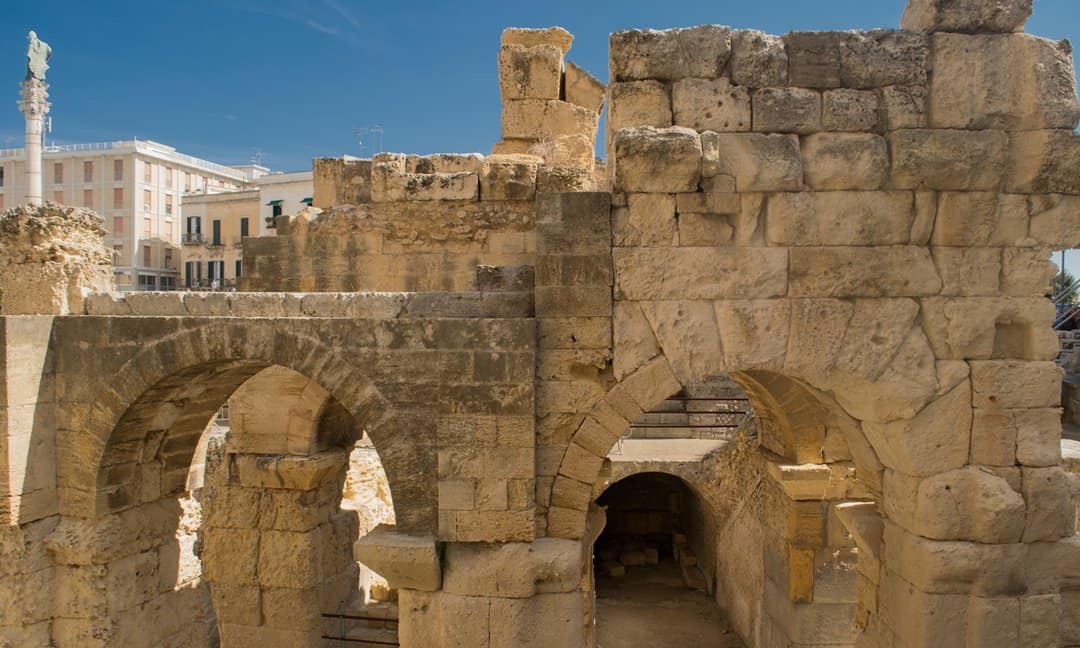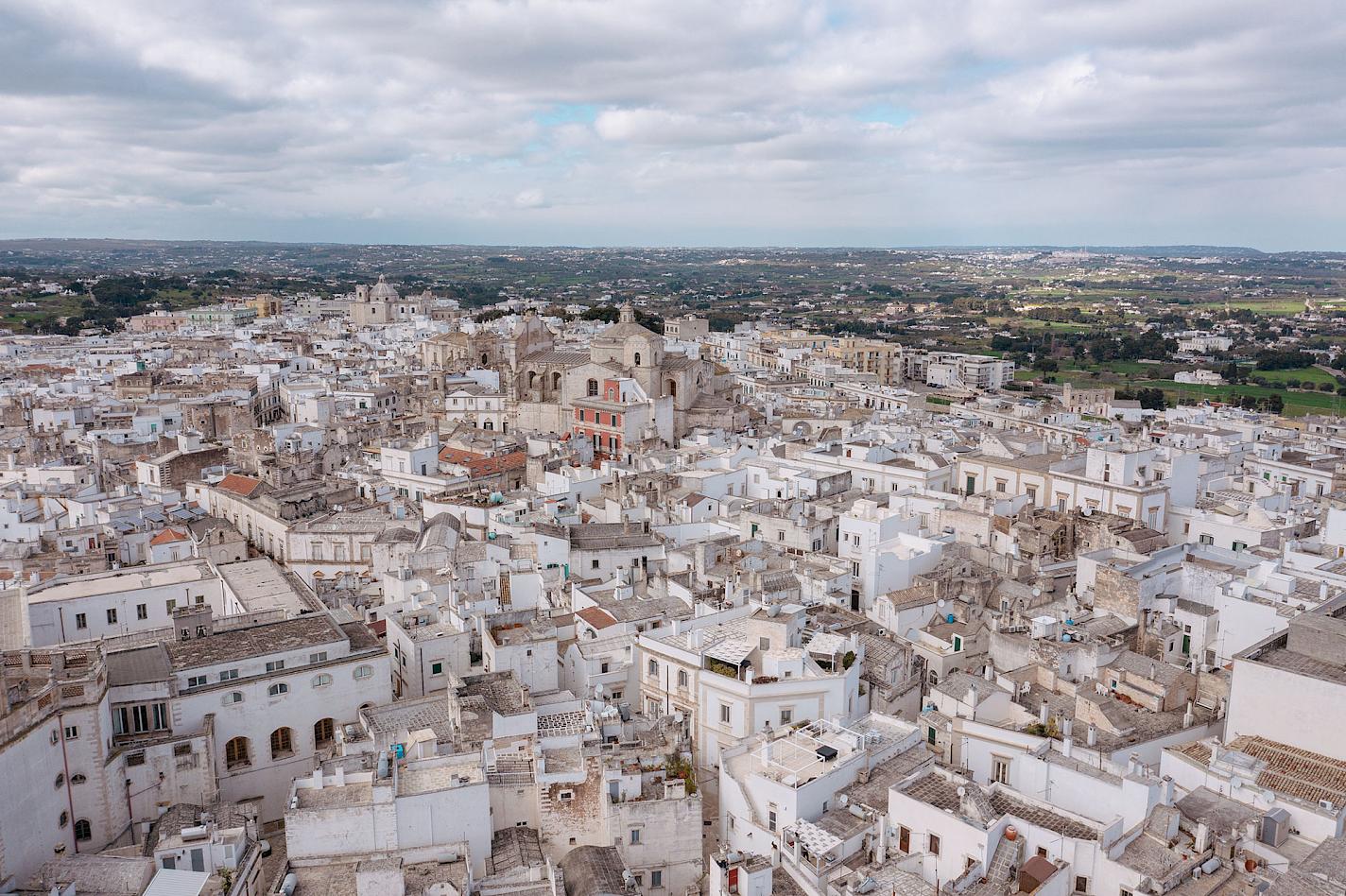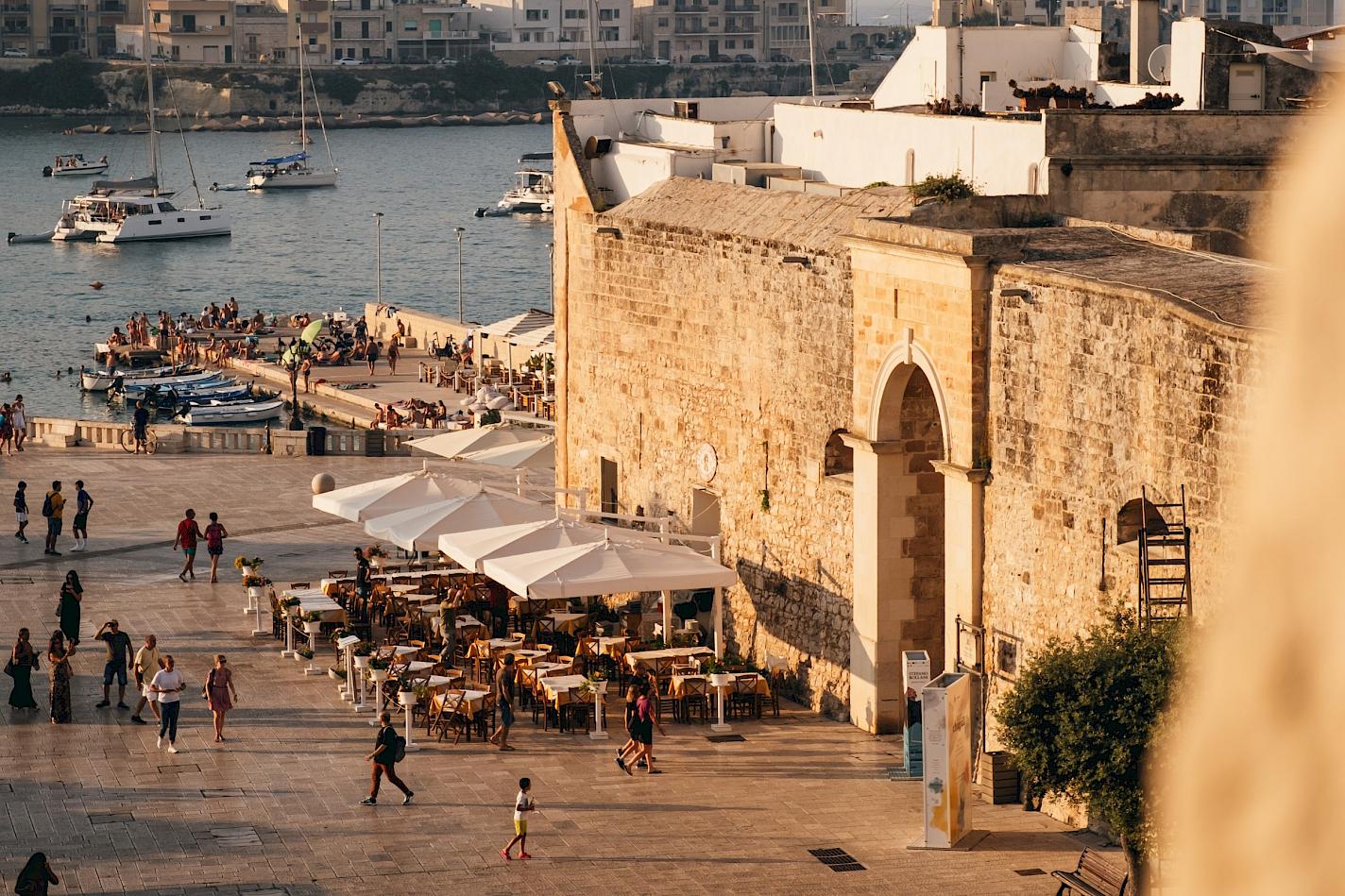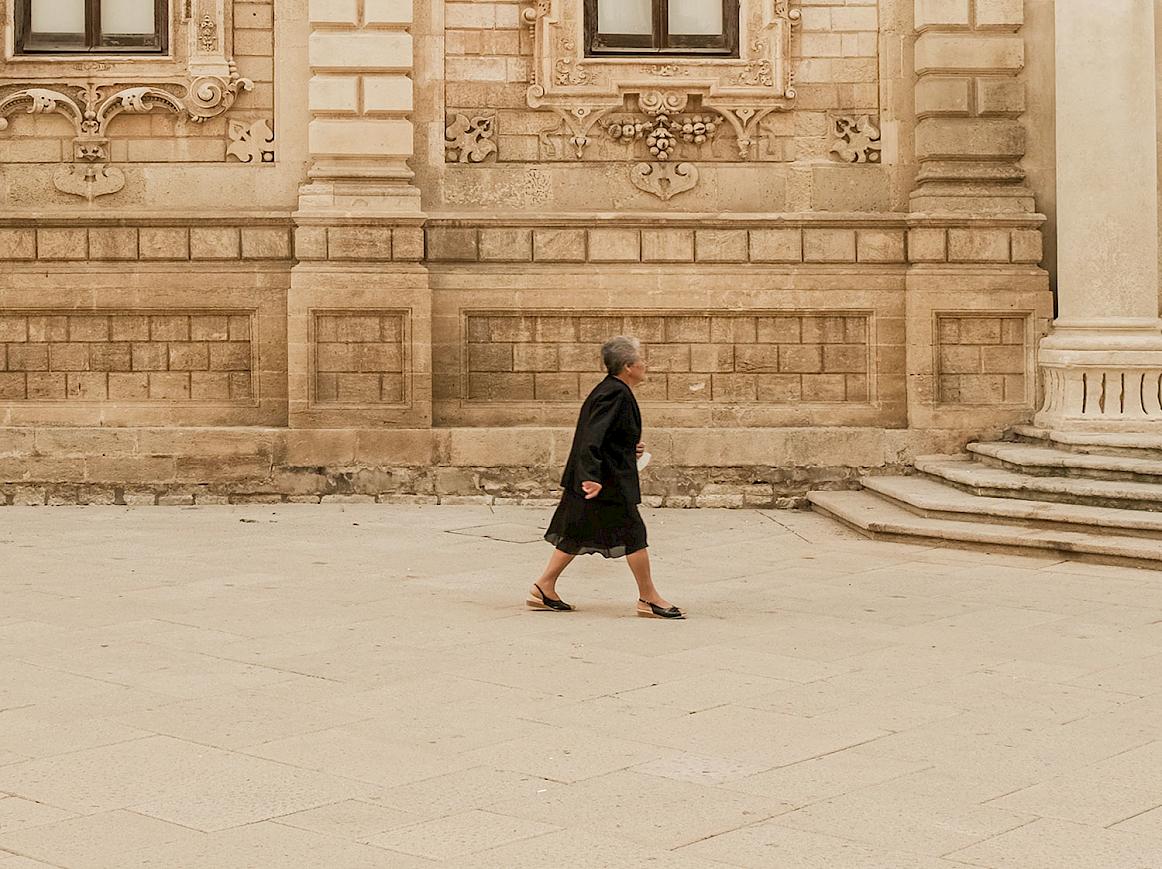Head south to Italy’s sun-soaked heel and you will take a deep dive into the rich history and authentic culture of this varied and beautiful landscape. Here, palaces, castles, chapels and churches in Baroque and Byzantine hill towns sit proudly among centuries-old olive trees, citrus groves and vineyards. Explore both the Adriatic coast to the east and the Ionian coast to the south-west, with their hundreds of kilometres of sandy beaches and rocky coves. Delight in the dry heat and cinematic light, and feast on the freshest food and regional delicacies that give previously undiscovered depth to the idea of delicious. Puglia is a revelation: a place of extraordinary beauty that reaches deep in your soul, teaching you to slow down and reset.
Puglia is a deceptively vast region that spans the heel of Italy and the same distance again to the north, along the Adriatic coast. Each area retains its own rich character and charm. From the architectural history of Terra di Bari, to the characteristic trulli and masserie of the Itria Valley, via the Baroque splendour and magnificent beaches of Salento, Puglia provides a rich and unique tapestry of places to explore and enjoy. While we prefer to immerse ourselves in a place, getting to know it over time, sometimes a day trip is all we have time for and, with a little planning, you can pack a lot of history, culture and gelato into just a few hours. Here are our suggestions of perfect places to discover on a day trip.
Inhabited since ancient times, with standing stones and tombs to prove it, Puglia has long been the meeting point between north and south, and east and west. Its strategic Mediterranean position and mostly flat landscape has made it a target for invasions throughout its long history, resulting in a wealth of cultural influences, including the Illyrians, Greeks, Messapians, Romans, Byzantines, Goths, Lombards, Arabs, Saracens, Normans and Swabians.
The region is said to have reached peak economic, social and political development in the 13th century under the rule of Frederick II of the Swabian dynasty, who fell madly in love with Puglia and, in joyous celebration, went on a building spree, leaving a 200-strong legacy of both religious and secular castles. Castel del Monte, near Bari, is one such castle, full of symbolic significance that blends elements from classical antiquity, the Islamic Orient and north European Cistercian Gothic. Castello di Lucera and Castello di Trani are two others that are worth exploring.
The Greeks, meanwhile, left behind their language, and Grico, an Italian-Greek dialect, is still spoken in villages, such as Soleto, Calimera and Sternatia, that dot the interior of the Salentine peninsula.


Martina Franca
This charming Baroque town lies in the heart of the Valle d’Itrie and is nestled in a landscape of olive groves, vineyards, trulli and masserie. The white of the plaster and limestone paving catch the beautiful Puglian light, making the whole town sparkle in the sunshine. Wander the maze of small streets that open onto pretty squares buzzing with café life and marvel at the history as you find yourself staring at buildings such as the Palazzo Ducale.


Otranto
This charming town with its brightly painted houses is also called Porta d’Oriente. Enclosed within the walls that overlook the southern shore of its natural harbour, it is Italy’s easternmost town and the first port of call from Greece and Albania. That also means it is the first town in Italy to greet sunrise on New Year’s Day and the celebrations are suitably lively. If you can tear yourself away from the sparkling clarity of the sea, the cathedral and the Aragonese castle deserve a visit.
Taranto
Also known as the ‘town of the two seas’ due to its geographical location between Mar Grande and Mar Piccolo, Taranto is a beautiful town at the junction of Puglia, Basilicata and Calabria. Its origins are so old that it is the only town built by Sparta outside Greece, and its history as a thriving economic and cultural centre is thanks to its commercial port, considered one of the most important in the Mediterranean since ancient times, when it was inhabited by mostly Greek settlers. The town is like an open-air museum, with numerous sites of historical and architectural interest, especially in the old town. We recommend you visit the Museo Archeologico Nazionale di Taranto.

LECCE
Known as Florence of the South and celebrated accordingly for its Baroque splendour, this stunning town is one of the most beautiful in southern Italy. Wander the streets and marvel at the churches, stopping for a drink, a bowl of pasta or a gelato as you take in the dazzling enormity of the architecture. You can read more on Lecce in this blog by our local guide Benedetta.
Puglia is rich with architectural variety and we have carefully built a portfolio of holiday properties that we think are the best of their kind. Some are traditional buildings that have been painstakingly restored, while others are modern villas that have been built using local materials by local artisans. From traditional trullis – the cone-shaped dry-stone, former agricultural buildings typical of the Itria Valley - to impressive palazzos with barrel-vaulted ceilings, via magnificent masserie, there is a wealth of choice. Sleek villas influenced by mid-century America, with Scandinavian and even Japanese influences sit near medieval mansions and fortified towers. Live the Italian coastal dream in an apartment where billowing linen curtains lead to a sea-view terrazzo, enjoy the magical convenience of a town house or relax in an elegant lamia, a traditional stone building built on a square or rectangular footprint.
You can even book an original Airstream in an olive grove.
There are places for families and groups of friends, for a relaxing reset, a week of partying or a combination of them all. Furniture is as likely to be an antique as a modern design piece, often from an Italian brand. Swim in incredible pools, in the warm, clear sea, or jump between the two. Revel in the abundance of fresh produce, prepping and cooking it in an outdoor kitchen, and dine outside. In Puglia, the outside spaces are celebrated as much as the interior ones. When the views, heat, smells, clarity of light, and freshness of the food are this good, and you can rely on the climate, this comes as no surprise.
This is Italy so food is, of course, a highlight. In fact, you could happily plan your entire trip around meals and delicious snacks. Puglia basks in warm sunshine and the climate means that fresh produce is abundant, sun-kissed and ridiculously tasty. Here, you’ll find shopping is a leisure activity, as is cooking in an outdoor kitchen. Taking the time to cook and share amazing food is one of the fundamental joys of life. If cooking isn’t your thing, breakfast, lunch and dinner are never far away in local cafés, bars and restaurants.
Along the coast, the fish and seafood are as fresh as they come. Olive oil, otherwise known as liquid gold, takes on the status of a separate food group, while those with a sweet tooth will be rewarded by various sugary delights, including pasticciotti – cream and sour cherry tarts typical of Lecce, pettole – fried dough balls that can be savoury too but the sweet versions are sprinkled with sugar, and cartellate – Arab-influenced, rose-shaped pastries that are flavoured with honey or grape juice.
While there is an abundance of fresh fruit and vegetables, there is also a strong line in bread, pasta and cheese. Buy the pane di Altamura and delight in its moreishness or snack on taralli – small rings of crispy bread dough - or try the similar frize and friselle. Focaccia is a highlight and for a regional take on pizza, try the stuffed loaves called puce or paposce.
For rich, dairy deliciousness and an exceptional taste that bears little resemblance to anything you can buy at home, try the burrata, a specialty of Puglia. Stracciatella and mozzarella enjoy the same acclaim. Try them and you’ll see why. For a local cheese that is a little firmer in texture and resembles a pear in shape, try caciocavallo. With its lovely, gentle saltiness it makes the perfect accompaniment to bruschetta.
And what is Italy without pasta? In Puglia it often comes in the shape of ears – orecchiette (little ears) being the most popular - but also try cicatelli and cavatelli, different versions on a theme. Neither bread nor pasta but equally delectable are panzerotti. Looking like a mini Cornish pasty with its frilled edge, it’s a delicious deep-fried pocket of dough filled with tomato and mozzarella. But do exercise restraint as they are very hot and you don’t want to burn your mouth or fingers in your eagerness to taste the melty middle. And there is always and forever gelato.
The heat of the summer months is intoxicating and perfect for pool lounging and sea swims and dinners outside. The shoulder seasons are cooler and less crowded and offer a gentler experience. The sea remains warm far into October and daily air temperatures are in the low twenties in spring and early autumn – perfect for exploring on foot or by bike, while winters are mostly mild.
Puglia has two airports, both on the Adriatic coast. Bari is north of Polignano a Mare, while Brindisi is further south between Ostuni and Lecce. While there are trains, a car is the easiest form of transport. Out of the heat of high summer Puglia is a bit of a magnet for cyclists, too.